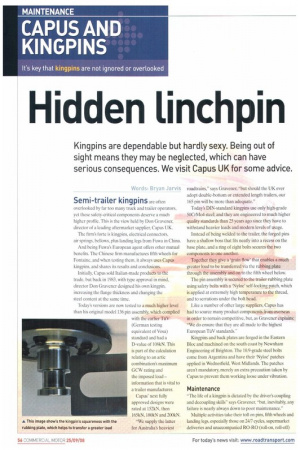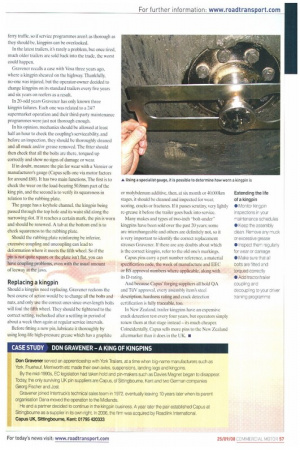Hidden linchpin
Page 56

Page 57

If you've noticed an error in this article please click here to report it so we can fix it.
Kingpins are dependable but hardly sexy. Being out of sight means they may be neglected, which can have serious consequences. We visit Capus UK for some advice.
Words: Bryan Jarvis
Semi-trailer kingpins are often overlooked by far too many truck and trailer operators, yet these safety-critical components deserve a much higher profile. This is the view held by Don Gravener, director of a leading aftermarket supplier, Capus UK.
The firm's forte is kingpins, electrical connectors.
air springs, bellows, plus landing legs from Fuwa in China.
And being Fuwa's European agent offers other mutual benefits. The Chinese firm manufactures fifth wheels for Fontaine, and when testing them, it always uses Capus kingpins, and shares its results and conclusions.
Initially. Capus sold Italian-made products to the trade, but back in 1983, with type approval in mind, director Don Gravener designed his own kingpin, increasing the flange thickness and changing the steel content at the same time.
Today's versions are now tested to a much higher level than his original model 136 pin assembly, which complied with the earlier TiN (German testing equivalent of Vosa) standard and had a D-value of 108kN. This is part of the calculation relating to an artic combination's maximum GCW rating and the imposed load — information that is vital to a trailer manufacturer.
Capus' next fully approved designs were rated at 152kN, then 165kN, 180kN and 200kN.
"We supply the latter for Australia's heaviest
roadtrains,says Gravener, but should the UK ever adopt double-bottom or extended length trailers, our 165 pin will be more than adequate."
Today's DIN-standard kingpins use only high-grade 50CrMo4 steel; and they are engineered to much higher quality standards than 25 years ago since they have to withstand heavier loads and modern levels of usage.
Instead of being welded to the trailer, the forged pins have a shallow boss that fits neatly into a recess on the base plate, and a ring of eight bolts secures the two components to one another.
Together they give a 'grain flow' that enables a much greater load to be transferred via the rubbing plate through the assembly and on to the fifth wheel below.
The pin assembly is secured to the trailer rubbing plate using safety bolts with a Nyloc' self-locking patch, which is applied at extremely high temperature to the thread, and to serrations under the bolt head.
Like a number of other large suppliers, Capus has had to source many product components from overseas in order to remain competitive, but, as Gravener explains: "We do ensure that they are all made to the highest European TUN standards."
Kingpins and back plates are forged in the Eastern Bloc and machined on the south coast by Newnham Engineering of Brighton. The 10.9-grade steel bolts come from Argentina and have their Nyloc' patches applied in Wedriesfield, West Midlands. The patches aren't mandatory, merely an extra precaution taken by Capus to prevent them working loose under vibration.
Maintenance
"The life of a kingpin is dictated by the driver's coupling and decoupling skills" says Gravener, "but, inevitably, any failure is nearly always down to poor maintenance."
Multiple activities take their toll on pins, fifth wheels and landing legs, especially those on 24/7 cycles, supermarket deliveries and unaccompanied RO-RO (roll-on, roll-off) ferry traffic, so if service programmes aren't as thorough as they should be, kingpins can be overlooked.
In the latest trailers, it's rarely a problem, but once tired, much older trailers are sold back into the trade, the worst could happen.
Gravener recalls a case with Vosa three years ago, where a kingpin sheared on the highway. Thankfully, no-one was injured, but the operator-owner decided to change kingpins on its standard trailers every five years and six years on reefers as a result.
In 20-odd years Gravener has only known three kingpin failures. Each one was related to a 24/7 supermarket operation and their third-party maintenance programmes were just not thorough enough.
In his opinion, mechanics should be allowed at least half an hour to check the coupling's serviceability, and before an inspection, they should be thoroughly cleaned and all muck and/or grease removed. The fitter should then check that all the bolts are there, torqued up correctly and show no signs of damage or wear.
If in doubt, measure the pin for wear with a Vernier or manufacturer's gauge (Capus sells one via motor factors for around £60). It has two main functions, The first is to check the wear on the load-bearing 50.8mm part of the king pin, and the second is to verify its squareness in relation to the rubbing plate.
The gauge has a keyhole channel, the kingpin being passed through the top hole and its waist slid along the narrowing slot. If it reaches a certain mark, the pin is worn and should be renewed, A tab at the bottom end is to check squareness to the rubbing plate.
Should the rubbing plate reinforcing be inferior, excessive coupling and uncoupling can lead to deformation where it meets the fifth wheel. So if the pin is not quite square or the plate isn't flat, you can have coupling problems, even with the usual amount of leeway at the jaws.
Replacing a kingpin
Should a kingpin need replacing. Gravener reckons the best course of action would be to change all the bolts and nuts, and only use the correct ones since over-length bolts will foul the fifth wheel. They should be tightened to the correct setting, rechecked after a settling-in period of about a week then again at regular service intervals.
Before fitting a new pin, lubricate it thoroughly by using long-life high-pressure grease which has a graphite or molybdenum additive, then, at six month or 40,000km stages, it should be cleaned and inspected for wear, scoring, cracks or fractures. If it passes scrutiny, very lightly re-grease it before the trailer goes back into service.
Many makes and types of two-inch "bolt-under" kingpins have been sold over the past 20 years; some are interchangeable and others are definitely not, so it is very important to identify the correct replacement stresses Gravener. If there are any doubts about which is the correct kingpin, refer to the old one's markings.
Capus pins carry a part number reference, a material specification code, the week of manufacture and EEC or BS approval numbers where applicable, along with its D-rating.
And because Capus' forging suppliers all hold QA and TtiV approval. every assembly item's steel description, hardness rating and crack detection certification is fully traceable, too.
In New Zealand, trailer kingpins have an expensive crack detection test every four years, but operators simply renew them at that stage instead — its much cheaper. Coincidentally, Capus sells more pins to the New Zealand aftermarket than it does in the UK. •




































































































































































